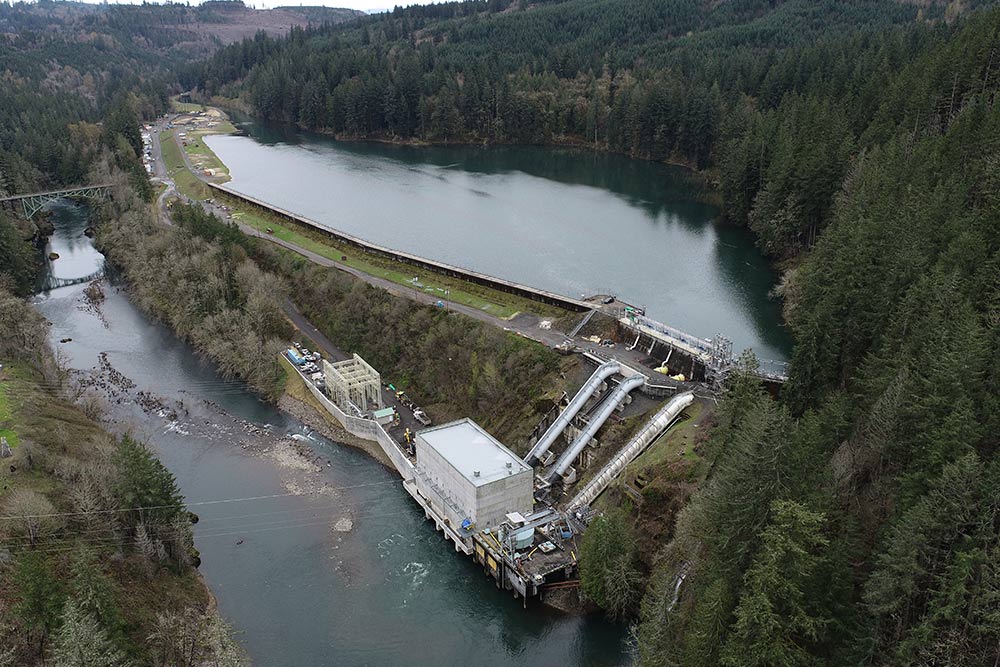Modernizing our hydropower plants – PGE’s oldest assets in the fight against climate change

June 12, 2023
As PGE works to achieve our 2030 and 2040 clean energy targets, we’re investing in the reliability, performance, and environmental quality of some of our oldest non-emitting resources: our hydropower plants. More than a century ago, hydropower played a critical role in helping electrify the Pacific Northwest. Today, hydroelectric projects continue to provide consistent and reliable clean power to Oregon customers – an essential service as PGE adds more intermittent renewable resources to our portfolio.
PGE’s recent investments include completion of the Faraday Resiliency & Repowering Project and recertification of the Pelton Round Butte project by the Low Impact Hydropower Institute.
Faraday Resiliency & Repowering Project
On the last day of January 2023, the new Faraday Powerhouse on the Clackamas River began generating emissions-free hydropower for PGE customers once again, after a multi-year construction process that began in 2019. This modernization effort improved the efficiency, reliability and operational safety of the historic Faraday Powerhouse, a 116-year-old plant located on the Clackamas River in Estacada. The powerhouse was replaced with a new, state-of-the-art structure designed for seismic safety and efficiency. In addition to allowing the plant to produce more consistent power regardless of river flows, the new highly efficient turbines are safer for juvenile fish migrating from the Clackamas River to the ocean. To honor Faraday’s key role in Estacada’s history and early growth, PGE preserved materials, documents, and oral histories from the plant, which we plan to share with the public both online and on site near the new facility.
Pelton Round Butte recertified by the Low Impact Hydropower Institute
On the other side of Mt. Hood, the Pelton Round Butte Project was recently recertified by the Low Impact Hydropower Institute, recognizing the project’s compliance with rigorous environmental stewardship criteria related to fish and wildlife protection, water quality and recreation. While there around 2,500 hydropower projects in the United States, just 200 are certified by LIHI.
To qualify, PGE and the Confederated Tribes of Warm Springs, co-owners of the three-dam complex on the Deschutes River, demonstrated responsible practices in several categories, from efforts to safely pass fish up- and downstream to ongoing water quality monitoring and protection of cultural resources. One area in which PGE and the Tribes especially shined was in our commitment to enhancing the entire watershed, demonstrated by our investment in habitat restoration projects throughout the Deschutes River Basin. These actions earned Pelton Round Butte a ‘Plus’ certification, acknowledging efforts above and beyond the standard requirements.
Together, these achievements demonstrate PGE’s dedication to maintaining the performance and reduced environmental impact of our hydropower facilities. Consistent, emissions-free hydropower is the perfect partner to renewables, like wind and solar, providing reliable and affordable baseload to meet customer demand.
While PGE continues to explore adoption of newer technologies for the clean energy future (like utility-scale battery storage systems), we’re also making the best use of our existing plants, allowing these projects to continue producing reliable carbon-free energy for decades to come.


1 / 2
An aerial photograph of the new Faraday Powerhouse from April 2023.
Pelton Dam is one of three hydroelectric dams operated by PGE and the Confederated Tribes of Warm Springs on the Deschutes River.
For more information contact:
Allison Dobscha, Portland General Electric